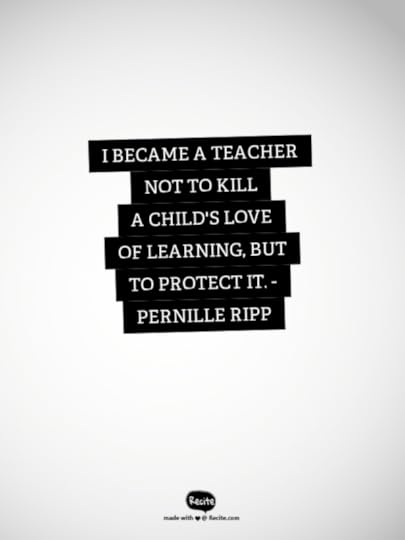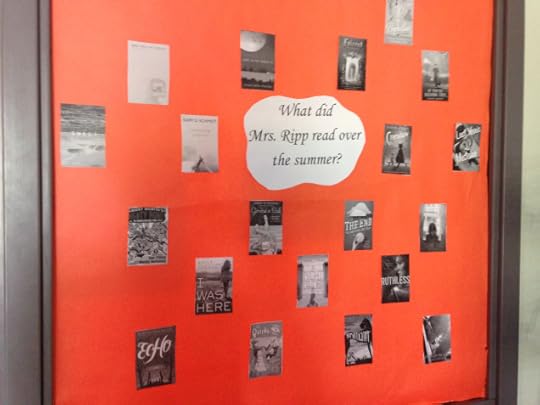Pernille Ripp's Blog, page 73
August 5, 2015
Can We Find A Better Term Than Struggling Readers?
 image from icanread
image from icanreadTo struggle means to contend with an adversary or opposing force. To struggle means to advance with violent effort. To struggle means to cope with an inability to perform well. Despite its relationship with these definitions, the term “struggling reader” has become one of the favored way to label our learners as we discuss their needs. A term that means to advance with violent effort is somehow now associated with developing as a reader, and I cringe every time I hear it.
It is not that I don’t see children fighting with words when they are learning to read. I see the tremendous effort. I see the hard work that goes into becoming a reader. And I see my older students still fight, sometimes word for word, as they process the text. They are in a struggle at times, yes. But they are not struggling readers. They are not battling an epic foe that will take them down somehow, because I can’t allow them to identify that way. I can’t allow that definition to define them in my own eyes. they are so much more than struggling readers.
When we allow a term like this to permeate our instruction, to permeate the conversations we have about students, we are viewing the children we teach only through one lens. We allow this term to overtake any other information we have on the child and the effort that they put into learning. When we label someone as struggling, we have, in essence, given them a box to place themselves in and for the rest of their lives they can choose to stay within that box knowing that no matter what they do, they will never stop struggling. That label becomes part of their identity. In our own minds as teachers, we also create a neat box to put them in as we plan our lessons and our own assumptions about what they can or cannot do taints their future path.
When we tell a child they are developing rather than struggling, then there is hope. Then there is a chance for them to think that some day whatever they struggle with will not be as hard for them. That they are developing their skills and working through the process. And yes, that process may take years and years, but that there will be success, however small, and that this learning journey is one they will be on for the rest of their lives. We don’t give them that chance for hope when we call them struggling readers.
In fact, why label them at all? Why not just call all of our readers just that; readers? Almost every child reads in some way. I see it in my own children when they pick up a book and point to the pictures, too young to process that there are words on the page as well. I see it in Thea, my 6 year-old, who is reading from memory and developing systems to figure out words. I see it in my 7th graders that slowly work through a page of text, exhausted by the end of it. They are readers. And yet, their path toward becoming better readers may be one that has obstacles, may be one filled with struggles, but that does not mean that they are the ones struggling at all times. That does not mean that one label will define who they are human beings, and nor should we let it. But that change starts with the very language we use to speak about our students. That change starts with us.
What do you think?
If you like what you read here, consider reading my book Passionate Learners – How to Engage and Empower Your Students. The 2nd edition and actual book-book (not just e-book!) comes out September 22nd from Routledge.
Filed under: assumptions, being me, books, Literacy, Reading, students


August 4, 2015
Stop Feeding the Beast – The Reading Myths We Pass on As Truth
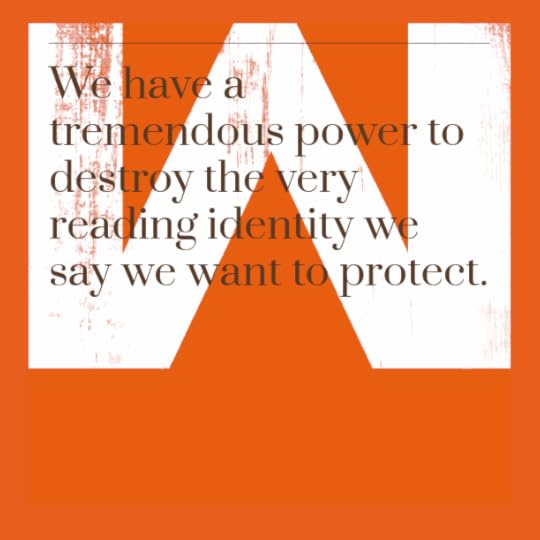
“This is not a “girl” book even if the cover makes you think it is, boys can love it too…”And I stop myself. And I cringe inwardly. And I want to rewind time for just 10 seconds and tell myself to stop. A “girl” book? What in the world is that? And since when did I label our classroom books by gender?
The stereotypes of reading seems to be a beast in itself. We feed the beast whenever we pass on hearsay as fact. We feed the beast whenever we fall victim to one of these stereotypical sayings without actually questioning it. Through our casual conversation we teach our students that there are books for girls and books for boys. We teach our students that a strong reader looks one way, while a struggling reader (God, I hate that term) is something else. We say these things as if they are the truth and then are surprised when our students adopt the very identities we create.
So what are the biggest myths that I know I have fed in my classroom?
“This is a girl/boy book.” I have said this many times as I try to book talk a book. I say it when I think the boys, in particular, will not give a book a fair chance because of its cover. I say it when I think the girls will find a book to be too violent, to have too much action. And every time I say it, I am teaching these kids that certain books are only meant for certain genders. What I forget is that I read all sorts of books. That I, as a female reader, like a good violent book. That I gravitate more toward “boy” books than “girl” books. So why do I continue to pass this on to my students? It stops now.
“This is an easy read.” Another common statement I have made while book talking. What I mean by it is that for most students the text will not prove difficult to understand, yet I know now that ease of reading looks very different from student to student. That what I may think is easy, even when I pretend to be a 7th grader, is not easy at all. That even if a book is short does not make it easy. Even if a book has a manageable story line does not make it easy. That “easy” means different things to different readers and therefore does not provide a good explanation to anyone. It stops now.
“He/she is a low or high reader.” Our obsession with classifying students based on their data does not help our students, it only helps the adults when we are discussing them. There is an urge in education to group kids according to data points so that rather than take the time to discuss each student, we can discuss them as a group. Yet the terms “low” or “high” make no sense when discussing readers. They make sense when we are discussing data points, but is that really all our students are? How many of us have taught students who were amazing readers, yet scored low on a test? What would we call them? We need to discuss students using their names and their actual qualities, not these shortened quantifiable terms that only box them in further. It stops now.
“Most boys don’t really like to read.” I don’t know how many years of teaching boys I need to finally stop saying this. Many boys like to read – period – but when we say that most don’t, we are telling them that what they love is not a masculine thing to do. That boys loving reading is something strange and different. If we want this to come true, we should just keep repeating this over and over. Our male readers will soon enough get the message that reading is for girls. It stops now.
“The older they get, the less they love books.” I used to believe this, until I started teaching middle school. Then I realized that it is not because students want to read less as they get older, they read less because we have less time for independent reading, and we dictate more of their reading life. Homework builds up as do other responsibilities outside of school. Compare a 5th grader who has 30 minutes of independent reading most days to my 7th graders that get a luxurious 10 minutes – who do you think reads more in a year? Also, I wonder if anyone would want to keep reading if they did not get time for it in school or had choice over what they read for several years? Sometimes I think it nearly a miracle that students’ love of reading can survive what we do to them in some educational settings. It stops now.
“But they are not really reading…” I used to be the hawk of independent reading, watching every kid and making sure that for the entire time their eyes were on the text. If they stopped I was there quickly to redirect. Independent reading time was for independent reading and by golly would I make sure that they used every single second of it. Yet I don’t read like that myself. When I love a book, I pause and wonder. When I love a book, I often look up to take a break, to settle my thoughts. When I love a book, my mind does not wander but I still fidget. That doesn’t need a redirection, that doesn’t need a conversation, that simply needs to be allowed to happen so I can get back to reading. Our students are not robots, we should not treat them as such. Re-direct when a child really needs it, not the moment they come up for air. It stops now.
“They are too old for read alouds…picture books…choral reading…Diary of Wimpy Kid…” Or whatever other thing we think our students are too old for. No child is too old for a read aloud. No child is too old for picture books. No child is too old for choral reading. No child is too old for books like Diary Of A Wimpy Kid. Perhaps if we spent more time showcasing how much fun reading really is, kids would actually believe us. It stops now.
The myths we allow ourselves to believe about reading will continue to shape the reading lives of those we teach. We have to stop ourselves from harming the reading experience. We have to take control of what we say, what we do, and what we think because our students are the ones being affected. We have a tremendous power to destroy the very reading identity we say we want to develop. It stops now. It stops with us.
If you like what you read here, consider reading my book Passionate Learners – How to Engage and Empower Your Students. The 2nd edition and actual book-book (not just e-book!) comes out September 22nd from Routledge.
Filed under: being a teacher, Literacy, Passion, Reading, student choice, student voice


August 3, 2015
I No Longer Want to Be Just A Witness
I have been thinking a lot about the inherent racism that my life is seeped in lately. Mostly because I do not face racism. Sexism yes, but racism, no. Mostly because I see the news and I am dumbfounded, saddened, and outraged. Mostly because I am a witness to how my students are treated outside of our school and the lives that they have. I am merely a witness but I don’t want to just witness anymore. I want to stop being a part of the problem and become part of the solution. But I don’t know how.
So when I see an infographic like this from The Sentencing Project

Or when I hear a Podcast like this “The Problem We All Live With” from This American Life and I shout at the radio at the injustice of it all, I cannot help but wonder; what can I do? Or more importantly, what can we do as educators? What can I do as a white educator who does not live this every single moment of my life? What will change in our classrooms so that we all become part of the solution rather than a continuation of the problem? How do we stop racism from flourishing rather than disappearing?
What do we do? Because we have to do something. And it has to be more than what we are doing now.
I am a passionate teacher in Oregon, Wisconsin, USA but originally from Denmark, who has taught 4th, 5th, and 7th grade. Proud techy geek, and mass consumer of incredible books. Creator of the Global Read Aloud Project , Co-founder of EdCamp MadWI , and believer in all children. The second edition of my first book “Passionate Learners – How to Engage and Empower Your Students” is available for pre-order now. Second book “Empowered Schools, Empowered Students – Creating Connected and Invested Learners” is out now from Corwin Press. Join our Passionate Learners community on Facebook and follow me on Twitter @PernilleRipp.
Filed under: being me


My Favorite Reads of This Summer – 2015 – Part 1
While summer still has a few weeks left in it, I have been surrounded by so many amazing reads that I felt I needed to share some of the incredible books I have been reading. We are so lucky to have such incredible books to share with our students (and ourselves!)
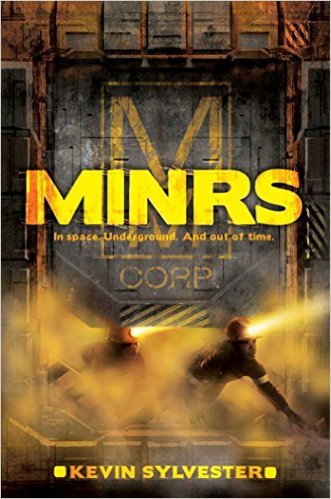
I just finished MiNRS by Kevin Sylvester last night and couldn’t believe how good it was. I love a great science fiction book and this one does not disappoint. Best part is that I can see handing this book to so many students to read, with it’s accessible language and action scenes, this is sure to be a crowd favorite for 4th graders and up.
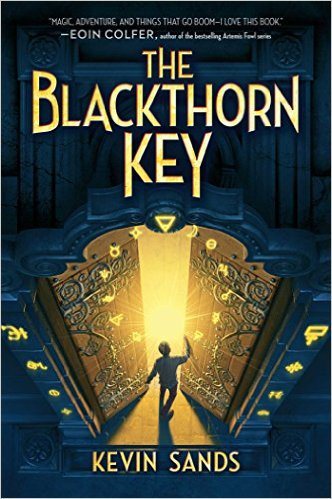 It is completely appropriate that The Blackthorn Key is released the very same day that I go back to school. Why? Because this is the book to give to students to read. This is a book for anyone who loves a good mystery, fantasy, action, and hopefully something that will turn into a series. This book, which again was an ARC given to me by Scholastic, will be a great book to hand to those students that loved Harry Potter or The False Prince. And it will be one that I cannot wait to read aloud.
It is completely appropriate that The Blackthorn Key is released the very same day that I go back to school. Why? Because this is the book to give to students to read. This is a book for anyone who loves a good mystery, fantasy, action, and hopefully something that will turn into a series. This book, which again was an ARC given to me by Scholastic, will be a great book to hand to those students that loved Harry Potter or The False Prince. And it will be one that I cannot wait to read aloud.
Bottom-line: 5th grade (or mature 4th graders due to the murders in it) and up.
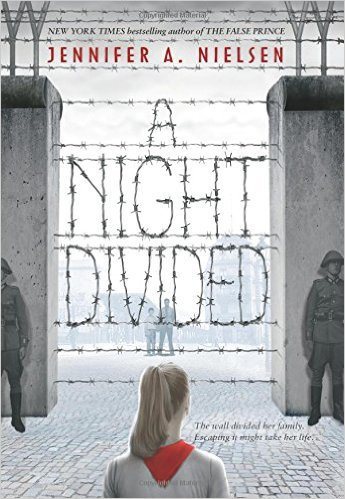
I have loved Jennifer’s books for many years. The False Prince and it’s sequels have been must-reads in my classroom for a long time. To me she is such a fantasy writer, one that weaves tales that sucks us in and leaves us wanting more. Imagine my surprise when I saw her new book A Night Divided. Long gone are the tales of battles, kings and queens, instead replaced with a stark narrative of what happened when the Berlin Wall was erected over night. It seemed so unlike her, but it is not. Her masterful story telling shines as we enter the would of Gerta and Fritz and their quest to have their dream survive. I was sucked into the story, needing to read just one more page until I sadly found myself at the end. Well done Jennifer.
So this book is a must add to 4th grade and up. There is shooting and death in it, after all it is historical fiction, but it is not graphic.
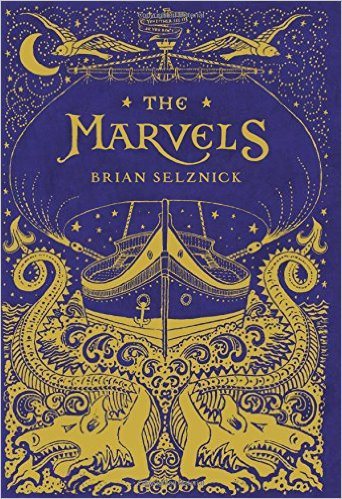
This is the post where I admit I have never read Wonderstruck. I have never read the The Invention of Hugo Cabret. I had watched the movie and marveled at the beautiful story. I have handed the books to students and told them to fall in love with them. But I had never read them myself. And I am not sure why.
So when I was handed The Marvels after standing in line at ILA for more than an hour, sharing the delightful company of Alison Hogan, I knew I had to read it. And it was worth every minute of standing in line. The book is beautiful, the story captures your imagination and leaves you pondering. I cannot wait to order this for my classroom and this time when I hand it to students really mean it when I say, “This is a must read.”
For 4th grade or perhaps even 3rd grade and up.

A favorite student of mine handed me a Barnes & Noble giftcard at the end of the year. I was surprised because I was pretty sure middle school teachers do not get gifts and yet she handed me one of the best things in the world; a chance to get more books. I therefore knew the books had to be special and I was not disappointed; Echo by Pam Munoz Ryan is a masterpiece. All 500+ pages of it. Once again she weaves a tale so masterful that you have to just read one more page, even if it is past midnight and you know tomorrow will be a long day. What I also loved about this book is it ageless and timeless quality, I immediately could think of 4th grader and 7th graders that needed to read this book. I am so thankful this book was recommended to me and now I am recommending it to you.

This is the book that took my breath away. This is the book that I read in less than 2 hours and then passed it on the very next day. This is the very first book that is a Global Read Aloud contender for 2016 for middle grades and up. Gut-wrenching, beautiful, and still resonating weeks later for me. Orbiting Jupiter by Gary D. Schmidt is a book that will resonate across our continents.
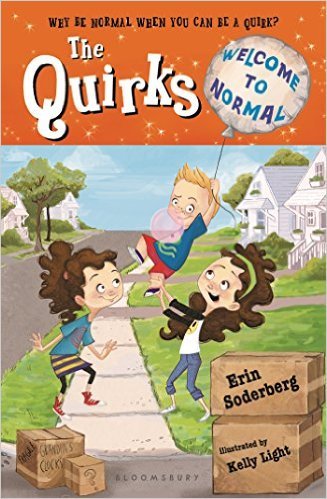
I had the honor of meeting Erin Soderberg at Nerdcamp and get a copy of her book. I loved The Quirks, funny, lighthearted, yet with an universal theme that many kids will connect with, Erin has written a great book for 3rd grade and up but also appropriate for middle schoolers.
Filed under: being me, books, Literacy, Reading


Books Are A Chance To See the World They Do Not Live In
My classroom library is a large mix of reads. Several thousands of books greet my 7th graders when they enter and are free to leave the room in their hands. Over the last year I have tried to expand it as much as I can afford to make sure that it represents the world we live in, that it represents their experiences, that they can find themselves within our library and use that knowledge to boost their own lives. My students need to see themselves in our books.
Yet, after a conversation with a great friend, I realized that it is not so much the need to find themselves within our library that I should be focused on because let’s face it, most of the world surrounding them is filled with images that look just like them, sound just like them, and share many of their same experiences. They are used to turning on the TV and seeing kids that are like them. They are used to picking up books and seeing like them in the pages. To many of my students seeing something other than white is uncommon. For my mostly white, rural population of readers it is important that they find the rest of the world in the pages. That through our library they can experience the world that they do not live in. That their emotions can be stretched to encompass events that they will most likely never have to encounter. That the library provides them with a window to things that they most likely will never have to live through such as racism, extreme poverty, no access to education, civil war, religious intolerance and a myriad of other issues that exists in only small ways in most of their lives.
So when we rally the cry for diverse books, it is not just so that our kids can find themselves within our pages and find books that mirror their experience. It is so they can see the world they do not live in. It is so they can see a world that may not make sense to them and start to make sense of it. It is so they can start to develop empathy, interest, and community with other parts of the world, other societies, other experiences that do not mirror their own.
Most of my students have plenty of books that they can find themselves in. My job is to provide them with ones they can’t.
I am a passionate teacher in Oregon, Wisconsin, USA but originally from Denmark, who has taught 4th, 5th, and 7th grade. Proud techy geek, and mass consumer of incredible books. Creator of the Global Read Aloud Project , Co-founder of EdCamp MadWI , and believer in all children. The second edition of my first book “Passionate Learners – How to Engage and Empower Your Students” is available for pre-order now. Second book “Empowered Schools, Empowered Students – Creating Connected and Invested Learners” is out now from Corwin Press. Join our Passionate Learners community on Facebook and follow me on Twitter @PernilleRipp.
Filed under: being a teacher, books, Literacy, Reading, student voice


August 2, 2015
I Didn’t Become A Teacher
I didn’t become a teacher so I could test my students into submission. So I could talk about them as data points and chart their growth on a spreadsheet.
I didn’t become a teacher so that I could make students cry. Or make them smile on command, make them sit still, make them schedule their breaks to my own benefit. Punish them into submission while I wondered why they seemed so disengaged.
I didn’t become a teacher so I could tell children which books they couldn’t read, where they couldn’t sit, and who they couldn’t work with.
I became a teacher so that I could help students make their voice louder. Help students believe more in themselves. Help students grow, learn, and thrive.
I became a teacher to help students find the guts to say, “This is what I need, this is what I want.”
I became a teacher not to kill a child’s love of learning, but to protect it.
And that is the reason why I am still a teacher to this day. I don’t want to forget that.
I am a passionate teacher in Oregon, Wisconsin, USA but originally from Denmark, who has taught 4th, 5th, and 7th grade. Proud techy geek, and mass consumer of incredible books. Creator of the Global Read Aloud Project , Co-founder of EdCamp MadWI , and believer in all children. The second edition of my first book “Passionate Learners – How to Engage and Empower Your Students” is available for pre-order now. Second book “Empowered Schools, Empowered Students – Creating Connected and Invested Learners” is out now from Corwin Press. Join our Passionate Learners community on Facebook and follow me on Twitter @PernilleRipp.
Filed under: being a teacher, being me


August 1, 2015
Before We Periscope From Our Schools, Let’s Think For a Moment
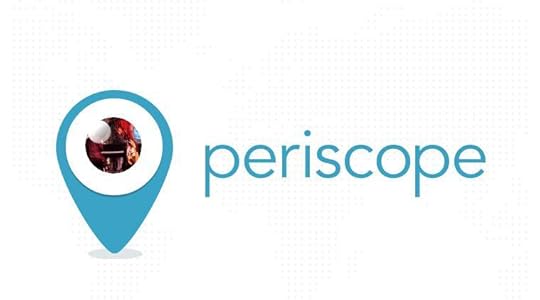
I fell in love with Periscope, the free live-streaming app created by Twitter, this summer while at ISTE. Free, instant access to events happening around the world – finally! The myriad of ways I could see implementing it in my classroom overwhelmed me in a good way. Kids could periscope our class at any time to bring the world in. Students could interact with other students around the world. Students could have a real-time audience at any time we needed. We could explore every day moments in cultures around the world. On and on, the ideas went.
Yet, when I thought about it some more, I started to second-guess my love for it a little bit. I didn’t fall out of love, but I did start to question my own ideas, as well as the professional responsibility that I carry not just as a teacher, but also as an active conference goer/speaker. So what has made me slow down?
The need for privacy. Student privacy and protecting it is at the forefront of my mind as a teacher who shares the work of their students. Some of my students cannot be shown on the internet for a variety of reasons and that is something I respect. What if that child walks by in the background? What if their voice is heard? What if students start filming from our classroom and do not know who can or cannot be shown on the internet? This by itself is enough to stop me from using Periscope in the classroom, but there is more.
The need for respect. When I videotape something I have editing abilities. That means that anything silly, stupid, weird, or somehow embarrassing does not have to be seen by anyone but us. The “live” part of the live-streaming means there is no delay, no editing, no take back. What if a child says something mortifying, screws up, fails in some way and the whole world potentially sees it? One thing is failing in front of your peers and embracing it, another thing is failing in front of strangers.
The need for attention. My first job is to teach the students in front of me. Not the world, not the parents, not other colleagues. So whenever a tool is brought into the classroom, I have to make sure it is not creating a barrier between me and students. Being focused on live-streaming something means that I am not working with students but instead acting as a cameraman. Even if I am live-streaming something that I am taking part in, I am still not giving them 100% of my attention because that would be multi-tasking, which we know decreases our focus.
The need for intimacy. Some of the biggest moments that have happened in our classroom has been when students have let their guards down and trusted us all inherently. When the door was closed and just we were present. That intimacy is gone the minute I start videotaping anything. So often we end up capturing the not quite as great moments because that is all we can get.
The need for purpose. If live-streaming something will add value to the purpose of what we are doing than I will consider doing it, but if it really only boosts me as someone who shares, or in some other way becomes more about me than my students then I am not for it. I worry that some will use Periscope to boost their own popularity and lose sight of why we are all doing this; for the kids.
The need for permission from parents. While most districts have technology policies and permission slips in place that include sharing the work, name, and image of students, Periscope, I feel, is a new level of sharing. So as a parent I would very much like the right to know about its use, the purpose of it, and also have the right to think about it. When we don’t ask, we take that right away from parents.
The need for permission from speakers. I had a wonderful discussion on Twitter on what the protocol is for periscoping professional development/keynotes and such. It seems there is none, but there probably should be. After all, if a conference has spent a lot of money bringing a speaker in and I have registered for it that does not mean we get to share that conference with the world. What we paid for is our own experience. So bottom line is to ask before you periscope and respect if someone says no.
So what Periscope might be great for?
Professional development where you interview other great thinkers or interact in some way and make it about the sharing of thought.
Students sharing knowledge in a pre-determined way. It would be a great idea to have students run a small talk or demonstration purposefully sharing their knowledge with the world.
Showcasing environment or other non-student immersed ideas. I love the idea of being able to send someone a live stream showcasing my classroom set up, library organization or something like that. Again, purpose, control, and meaningfulness is at the forefront of my thinking here.
Tuning into a specific part of the world to see what daily life is like there. This fits nicely with the tag line of “Explore the world through someone else’s eyes.”
So while there are definite great uses to Periscope, I am hesitant to bring it into my classroom when the students are there. Perhaps I am too scared? Perhaps I don’t know enough? I would love to get your opinion on this.
I am a passionate teacher in Oregon, Wisconsin, USA but originally from Denmark, who has taught 4th, 5th, and 7th grade. Proud techy geek, and mass consumer of incredible books. Creator of the Global Read Aloud Project , Co-founder of EdCamp MadWI , and believer in all children. The second edition of my first book “Passionate Learners – How to Engage and Empower Your Students” is available for pre-order now. Second book “Empowered Schools, Empowered Students – Creating Connected and Invested Learners” is out now from Corwin Press. Join our Passionate Learners community on Facebook and follow me on Twitter @PernilleRipp.
Filed under: being me, new year, students, technology


July 31, 2015
My Classroom Without Students
I always feel funny posting pictures of my classroom because it is not cute, nor lively, nor exciting. It is utilitarian, empty without students, and we have space to roam. Perhaps, though, in its bareness is its beauty. It is a vessel for learning, waiting for my many students to fill it with personality and life. The 1 month countdown has begun, another year awaits…
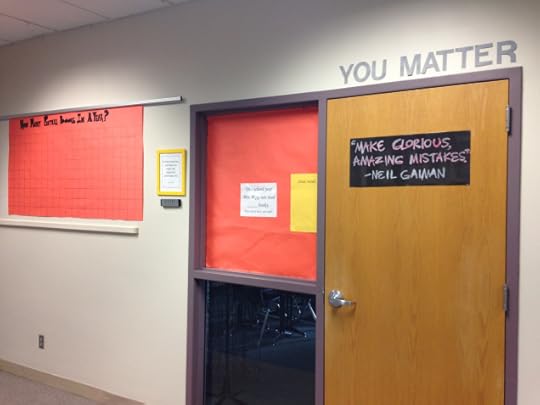
The front display as they come close to the room, most of the day I teach with an open door unless we get loud.

This idea is adapted from the fabulous Jillian Heise who does a picture book a day with her 7th and 8th graders. I don’t know if we will do one every single day but I plan on doing as many as possible, so of course we need a place to showcase them.

I don’t believe in the power of motivational posters, but this is I believe in, every single day.
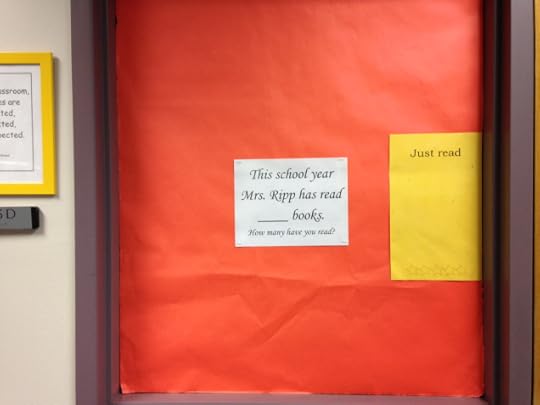
An empty bulletin board waiting to be filled with books. Every staff member at our school has a yellow “Just Read” poster to show students that we are a community of readers.
On the other side of the door is my “Read this summer” poster. This was updated as of last week.
This is almost the view from the door, slightly to the left of it. I have placed tables in pods for now but know that they will be moved however the students see fit when they arrive. Whatever they need to do with them to make learning accessible works for me. I love my window so much, most days we leave the light off. Students flock to sit in the window and read.
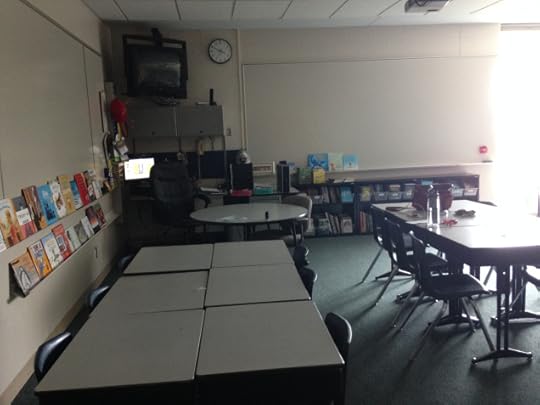
View toward my desk. It is in the corner on purpose; I don’t want to sit behind it away from students. I work with students at the small round table when needed or they take it over. I am just starting to show off all of the new picture books.

Also up by the front door, my old rocking chair and easel is where we will gather when we have our mini lessons. There are bean bags for the students to use, as well as carpet squares. I don’t ask students to sit on the floor unless they want to, what matters is that we can gather as a group and talk.
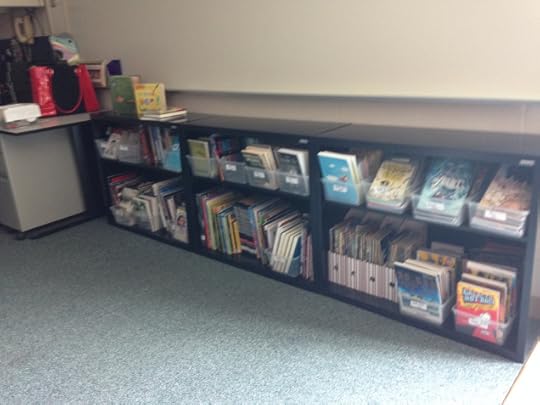
A slightly blurry picture of my non-fiction and graphic novel bookshelves. I am so excited my school got me these, less excited that I already filled them.

Probably one of the best things about our classroom; the picture books. How can you not just want to read them all?
There you have it, a tour of an empty classroom, waiting for the students to make it important.
I am a passionate teacher in Oregon, Wisconsin, USA but originally from Denmark, who has taught 4th, 5th, and 7th grade. Proud techy geek, and mass consumer of incredible books. Creator of the Global Read Aloud Project , Co-founder of EdCamp MadWI , and believer in all children. The second edition of my first book “Passionate Learners – How to Engage and Empower Your Students” is available for pre-order now. Second book “Empowered Schools, Empowered Students – Creating Connected and Invested Learners” is out now from Corwin Press. Join our Passionate Learners community on Facebook and follow me on Twitter @PernilleRipp.
Filed under: being me, classroom setup, new year


July 30, 2015
Why Picture Books – 5 Reasons Why They Belong in Every Classroom
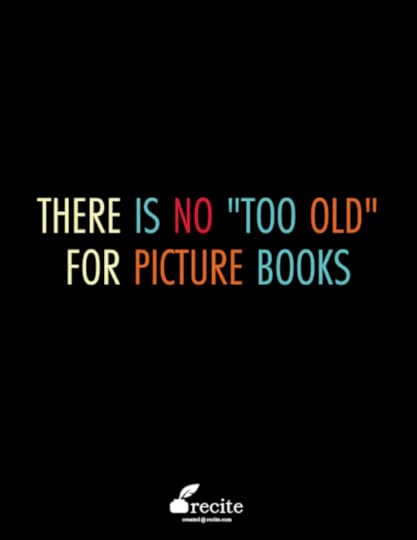
I don’t remember when I fell out of love with picture books, but I do remember wondering why any teacher would invest any money in them if they were not teaching young kids. After all, picture books are so expensive and there is not much to them. No, I would rather invest my money in chapter books, that is where you get the most value. So picture books? Perhaps a few selected mentor texts in my 4th grade classroom.
I don’t remember when I fell back in love with picture books. Perhaps it was the first time students laughed out loud with me at Chick and Pug. Perhaps it was the first time students held their breath with me when I read out loud Pete & Pickles. Perhaps when I cried while I read Ivan: The Remarkable True Story of the Shopping Mall Gorilla. Perhaps it was when those kids that hated reading so much would ask if they could borrow some picture books so they could read to their little sister, and then tell me all about their night the very next day. Whatever happened, I now know that picture books belong in every classroom, for every reader. Here is why.
Picture books give us a common language.
I love how we can read a picture book and then refer back to it again and again as we weave our threads of community throughout the year. The students remember it, they read it again, and the reminisce about reading it. In a short amount of time we create a foundation for the students to bond through and a way for us to be a part of their world. Even within my 45 minutes of instruction time, I know I can at least read a picture book out loud, most days. And if you don’t teach English, read one once in a while, students need community in all classes, not just the literacy ones.
Picture books can teach us complex matters in a simple way.
When my students became curious about the great Malcolm X, I read them Malcolm Little. When we spoke of the civil rights movement and the every day segregation that happened, I read them Ruth and the Green Book. When they feel completely alone, I read them The Invisible Boy. When we have to talk about what our actions do to others, we read aloud Each Kindness which with its less than perfect ending is a perfect mirror of what life is really like. These books don’t offer all of the knowledge my students need, but they give us a chance to start the conversation. There are so many curriculum picture books out there waiting for us to embrace them for the knowledge they give us, not written for the young reader but for mature kids that can take the information and do something with it. Don’t leave your students out.
Picture books can make us feel successful when we have lost our way.
I often teach students who don’t think they will ever be a strong reader. Who do not go home and read, who do not gravitate toward books, but instead spend them them flipping pages and waiting for the bell. I hand these kids stacks of picture books. I tell them to immerse themselves and come up when they are ready for more. There is no judgment from other kids, nor jealousy. Our picture books are waiting for anyone to read them.
Picture books relieve stress.
If a child is having a bad day, I can hand them a stack of Elephant and Piggie books and know that at some point a small smile will form. I can hand them anything fantastical that is nothing like their real life and for a moment they have a reprieve. How often do our students get a chance to escape the stress of their lives and still work? Picture books offer me that opportunity.
Picture books can make us believe that we can read well.
For the child who gave up a long time ago on reading. For the child who does not believe that school is for them. For the child who is angry, who is misplaced, who is lost; picture books can make the biggest difference. I once taught a student so angry he scared the rest of the class, but if I could get a stack of picture books in his hands before it was too late, send him to a quiet place, he deescalated. Picture books were not a threat, nor were they work. They were an escape and something that made him feel successful. If a child does not think they will ever read as well as the others, get them picture books, have them digest them slowly, see their progress and see them start to believe that they too can be readers, that they too can belong. There is no shame in picture books, not when we embrace them fully as teachers. Not when we make them a part of our classroom. Remove the stigma so that students can find success within their pages, rather than feel there are no books for them out there.
PS: To see some of new favorite picture books, go to the list part 1 and the list part 2. You have been warned, they are amazing.
I am a passionate teacher in Oregon, Wisconsin, USA but originally from Denmark, who has taught 4th, 5th, and 7th grade. Proud techy geek, and mass consumer of incredible books. Creator of the Global Read Aloud Project , Co-founder of EdCamp MadWI , and believer in all children. The second edition of my first book “Passionate Learners – How to Engage and Empower Your Students” is available for pre-order now. Second book “Empowered Schools, Empowered Students – Creating Connected and Invested Learners” is out now from Corwin Press. Join our Passionate Learners community on Facebook and follow me on Twitter @PernilleRipp.
Filed under: books, Literacy, Reading, students


As We Start Another Year

There are journeys we start where that path is laid out, the route determined, the destination clear. While hard at times, they follow a set course and we plod along, knowing where we will end up. Knowing where our hearts will be once we finally get there. Then there are those journeys that start when something ends, when something abruptly happens and we have a moment of clarity and we realize that now another direction is needed. Sometimes these journeys start without us knowing and we don’t discover them until we are far on our path. Confused we wonder how we get here, where we are going, and why we didn’t know we were traveling anew. Those are the journeys that can change us the most.
We are travelers in education. Always searching for a path, always searching for a way. Tirelessly plodding along, sometimes pushing our students ahead of us, other times dragging them along. Our journey changes often, seemingly from year to year is a guarantee by now. We notice as the years pass, as summer inches closer and then ends. We notice when a crop of new students show up and then leave us. We notice seasons, months, and sometimes even weeks as we plan for our hopes and dreams.
Yet the daily journeys we take, the journey we begin and end within the span of 8 hours is often viewed as minor or insignificant, not worthy of our daily ponderings, not quite worthy of our dreams. After all, a day is simply a step, not a destination by any means. Yet, it is these journeys, the ones that happen every single day in our rooms that can matter the most to our students. To those children that travel along with us. A single day can change their course for many years to come. A single decision made by a teacher can change their path forever. We forget about that responsibility, probably a wise move in some ways, lest we drive ourselves crazy with the knowledge that even our small movements can cause oceans of change for others. Yet those journeys are the ones we should be watching.
Every day we have a choice to make; do I teach my students or do we learn together? Do we explore or do we wait for knowledge to find us? Do we stay on our path or do we change course? Do we support or do we hinder? Do we encourage or do we fault when missteps happen and our path gets rumpled? Do we always take the lead or can students show us the way? Do we listen to their voices when they tell us to change course or do we stubbornly stick to the path because we know best?
The day-to-day wrapped up in it mundanity offers us the perfect opportunity to make a change. Change doesn’t seem scary when you think of it as trying something for just one day. You can go one day without punishing. You can go one day without homework. You can try for one day to ask students what they want. You can try for one day to stop talking so much. One day does not seem like much, but it can be the seed to bigger change.
We have a choice of whether or not we notice the day-to-day or if we continue to plan as if we have unlimited time to reach every child. We don’t. We don’t know when the students we teach will no longer be ours. We don’t know when a child has moved beyond our grasp. So as we plan for the long, focus in on the short. Yes, keep the destination in mind, but don’t forget about the journey. What you do today has an incredible impact on what you will do tomorrow. Make each step count, make each step worthy of your time, and don’t forget that it is ok to get lost once in a while, as long as you bring your students with you as you try to find your way.
I am a passionate teacher in Oregon, Wisconsin, USA but originally from Denmark, who has taught 4th, 5th, and 7th grade. Proud techy geek, and mass consumer of incredible books. Creator of the Global Read Aloud Project , Co-founder of EdCamp MadWI , and believer in all children. The second edition of my first book “Passionate Learners – How to Engage and Empower Your Students” is available for pre-order now. Second book “Empowered Schools, Empowered Students – Creating Connected and Invested Learners” is out now from Corwin Press. Join our Passionate Learners community on Facebook and follow me on Twitter @PernilleRipp.
Filed under: Be the change, being a teacher, new year




